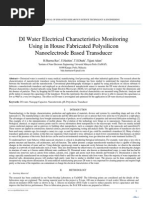Embedded Ethernet Module - Tool For Researcher: Ms. Pooja Kulkarni, Ms. Snehal Upadhye, Dr. (MRS.) Neelima Iyer
Embedded Ethernet Module - Tool For Researcher: Ms. Pooja Kulkarni, Ms. Snehal Upadhye, Dr. (MRS.) Neelima Iyer
Uploaded by
ER Publications, IndiaCopyright:
Available Formats
Embedded Ethernet Module - Tool For Researcher: Ms. Pooja Kulkarni, Ms. Snehal Upadhye, Dr. (MRS.) Neelima Iyer
Embedded Ethernet Module - Tool For Researcher: Ms. Pooja Kulkarni, Ms. Snehal Upadhye, Dr. (MRS.) Neelima Iyer
Uploaded by
ER Publications, IndiaOriginal Title
Copyright
Available Formats
Share this document
Did you find this document useful?
Is this content inappropriate?
Copyright:
Available Formats
Embedded Ethernet Module - Tool For Researcher: Ms. Pooja Kulkarni, Ms. Snehal Upadhye, Dr. (MRS.) Neelima Iyer
Embedded Ethernet Module - Tool For Researcher: Ms. Pooja Kulkarni, Ms. Snehal Upadhye, Dr. (MRS.) Neelima Iyer
Uploaded by
ER Publications, IndiaCopyright:
Available Formats
INTERNATIONAL JOURNAL OF ENHANCED RESEARCH IN SCIENCE TECHNOLOGY & ENGINEERING VOL. 1, ISSUE 1, OCT.
2012
Embedded Ethernet Module Tool for Researcher
Ms. Pooja Kulkarni1, Ms. Snehal Upadhye2, Dr. (Mrs.) Neelima Iyer3
CSIR-National Chemical Laboratory, Instrumentation & Communication Unit, Pune, India 1 pm.kulkarni@ncl.res.in, 2sk.upadhye@ncl.res.in, 3ns.iyer@ncl.res.in
Abstract - Embedded Ethernet is nothing but a microcontroller which is able to communicate with the network. This paper implements scheme for Ethernet connectivity between an embedded board (STR912FW44X) and PC for development of embedded web server. The board has an Ethernet controller (STE100P) which is 10/100 fast Ethernet 3.3V Transceiver. ARM 9 core IC STR912FW44 has Media Access Controller (MAC)/ Direct Memory Access (DMA) layer which are used for interfacing with the Ethernet controller IC. Proposed work aims at establishment of connectivity between embedded board and PC using RJ45 crossover Ethernet cable. A web page has been displayed successfully on PC. The changes in ADC values have been observed on webpage. Total development is carried out through Keil Vision IDE 4.23. Development is done using Embedded C language. Keywords - ARM9 processor, Embedded Ethernet, Web server, Protocol, Keil compiler.
I. INTRODUCTION Ethernet is the networking technology used in many offices and homes to enable computers to communicate and share resources. For many years, embedded systems and ethernet networks existed in separate worlds. Ethernet was available only to desktop computers and hence embedded systems that needed to exchange information with other computers were limited to some interfaces. But the developments in technology now make it possible for embedded systems to communicate in local ethernet networks. Availability of inexpensive controller chips; that handle the ethernet communications has made ethernet feasible for embedded systems. Embedded Ethernet is a "single-chip implementation of the Ethernet networking standard." Embedded web server- An embedded web server is microcontroller that contains an Internet software suite as well as application code for monitoring and controlling systems. ARM9 STR912FW44 controller used is a 32-bit 96 MHz intelligence. ARM9 controllers are extensively used in consumer electronics, including mobile phones, digital media and music players, hand-held game consoles, calculators and computer peripherals such as hard drives and routers. ARM9 has on chip Ethernet in addition to all other on chip peripherals of ARM7. Embedded Ethernet is one of the most powerful tools considered in networking. IEEE 802.3 Ethernet standard protocol is used. It supports data transfer rates of 10 Mbps and 100Mbps. It is therefore also known as 10 Base-T and 100 Base-T. II. SYSTEM DESCRIPTION
LCD
ADC
ARM9 (STR912FW44)
Ethernet controller STE100P
PC
Figure 1: Block diagram Above diagram shows that all devices are connected to the processor and the analog to digital converter (ADC) converters are used to convert analog data into digital data.STR912FW44 controller has MAC layer which manages the sending and receiving of network data, to a physical layer and direct memory access (DMA) interface. Ethernet interface module consists of an Ethernet controller chip STE100P which is provided by ST microelectronics. This controller uses a media-independent interface (MII) that connects to a device at a physical layer (PHY). This Ethernet controller provides two data rates 100mbps and 10mbps. Ethernet controller hardware normally handles the sending and receiving of frames, detecting collision and deciding when to try again after a collision. RJ45 connector is used for connection between PC and board.
www.erpublications.com
INTERNATIONAL JOURNAL OF ENHANCED RESEARCH IN SCIENCE TECHNOLOGY & ENGINEERING VOL. 1, ISSUE 1, OCT. 2012
A. ARM9 Processor: STR912FW44 is a microcontroller which is based on a supporting embedded tracking 32bit ARM966E-S CPU which run up to 200MHz. ARM9 processor is having Harvard bus architecture with 256KB/512KB Main Flash, 32KB 2nd Flash memory, 9 programmable DMA channel, 80 I/O pins, 4 timers of 16 bit, 8channel 10 bit A/D converter, Vector interrupt controller, real time clock provides calendar functions, tamper detection, and wake-up functions and various communication interfaces. B. Ethernet Controller: The STE100P, also referred to as STEPHY1, is a high performance Fast Ethernet physical layer interface for 10Base-T and 100Base-TX applications. The STEPHY1 supports both half-duplex and full duplex operation, at 10 and 100 Mbps operation. STE100P is having MII interface and supports Standard CSMA/CD or full duplex operation.
C. Protocols used: TCP/IP protocol based HTTP Hypertext transfer protocol (HTTP) is a simple protocol that is based on TCP/IP protocol stack. HTTP uses TCP (Transmission Control Protocol) for requesting and sending web pages. HTTP is based on a simple client/server concept. HTTP client and server communicate via TCP connection. As a default TCP port address 80 will be used. Internet Protocol:
The Internet Protocol (IP) is the network layer protocol. It provides a connection-less service. The job of IP is to route and send a packet to the packet's destination. Transmission Control Protocol:
Transmission Control Protocol (TCP) runs on top of IP, and provides a connection oriented service between the sender and the receiver. TCP provides a reliable way to send data between machines, but dealing with the data is up to the software on each side of the connection. Once a TCP connection is established, data is literally packets of raw bytes.
D. Initialization of Ethernet controller:
Initialize Controller.
Get base IO address, Get IRQ values.
Reset MAC, Reset PHY
www.erpublications.com
INTERNATIONAL JOURNAL OF ENHANCED RESEARCH IN SCIENCE TECHNOLOGY & ENGINEERING VOL. 1, ISSUE 1, OCT. 2012
Check for STE100P PHY
Yes
No Set the MAC address to corresponding register. Prepare Transmit descriptor and buffer, Prepare Receive descriptor and buffer.
Configure the PHY Device.
Enable the ENET interrupts.
Enable Tx & Rx functions.
END
III. EXPERIMENTAL SETUP
Figure 2: Experimental Setup
www.erpublications.com
INTERNATIONAL JOURNAL OF ENHANCED RESEARCH IN SCIENCE TECHNOLOGY & ENGINEERING VOL. 1, ISSUE 1, OCT. 2012
The experimental setup of the embedded web server is shown in the following figure 2. Micro board is connected to the Ethernet controller of the network. Power to the micro board is given through USB. JTAG debugger is connected to the USB port of PC and the other end to the board for downloading the program. Ethernet crossover cable is used for the connection between micro board and PC Ethernet socket. Testing of web-browser: Initially the target is tested for operating system, which is done by booting the target on command prompt. Boot using the ping commends shows the information of received and sending packets. In this user has to enter the IP address. LAN controller on server sends the request to the router that processes and checks the system for the IP address entered. If IP address of user is matched with that of target board with same network ID but different host ID connection is established. IV.SOFTWARE DEVELOPMENT Software development is carried out using Keil Vision IDE 4.23 compiler and embedded C language. Program code is downloaded on micro board through JTAG Debugger. System first initializes the ports related to transmission and reception, PHY, RX-TX descriptors MAC controller and LCD. One of the major parts of initialization is identification and configuration of STE100P PHY. STE100P PHY then carries out process of Auto negotiation to determine speed and mode (i.e. half duplex or full duplex) of transmission. Receive operation is then initiated. The package containing transmitted data is checked for the length configuration and it calls for TCP/IP stack with standard ports. Different interactive messages are displayed on 16 x 2 liquid crystal display (LCD) during whole operation for user ease. Software development for web page :
Figure 3: Steps to display a Web page The web server receives a request from the web browser. On this request, a specific file is required as answer (Step 1 in fig. 3). After that, the web server tries to get access on the file system of the requested computer. Then it attempts to find the desired file (Step 2). After the successful search the web server reads the entire file (Step 3) and transmits it as an answer (HTTP response comprising of header and content object) to the web browser (Step 4), the web page then gets displayed on the computer screen. The web content is built by individual files. The base is built by static files with HTML pages. V. RESULTS Command window in fig.4 shows embedded web servers response to the ping command. Now the embedded web server is responding to the client. Request is made to the embedded web server, by typing the IP address of the server in the clients browser. If the IP address entered is correct and matches to that of the server, it shows following result.
Figure 4: Connection established
www.erpublications.com
INTERNATIONAL JOURNAL OF ENHANCED RESEARCH IN SCIENCE TECHNOLOGY & ENGINEERING VOL. 1, ISSUE 1, OCT. 2012
The message encoded in an HTML file which was included in the project file has been successfully observed on the webpage. Also the ADC value bar is obtained on the webpage. The web page shows the values of two analog inputs (AN0 and AN1) and the variation in ADC voltage levels and board specifications as shown in the fig: 5. this html page shows two ADC inputs with different voltage levels.
Figure 5: Developed web page
This tiny web server needs very little resources and therefore has some restrictions like ; only one active TCP session at any one time , only one web page , no GIF/JPG graphics possible etc. This is a dynamic webpage that is interactive page that accept input from the operator and provide feedback on the status of the embedded system VI. CONCLUSION The webpage has been successfully developed by establishing Ethernet connectivity between the embedded system and PC. The embedded web server that has been designed can be used in educational institutions, offices and many other places. VII. FUTURE SCOPE Work is being carried out for hand held module having Ethernet controller RTL8201CL and Atmel ARM9 AT91SAM9263 core. Module will be used for chemical engineering applications at the institute. ACKNOWLEDGMENT We are extremely thankful to Dr. Sourav Pal, Director, National Chemical Laboratory for encouragement. We acknowledge support from Dnyanesh Joshi and Rohit Patil, , Instrumentation and Communication Unit, NCL, Pune. REFERENCES
Jan Axelson,Embedded Ethernet and Internet Complete, 2007. ST Electronics,STR91xF ARM9-based microcontroller family Reference Manual, September, 2006. David Brash, The ARM Architecture Version, ARM White Paper, January 2002. Brian W. Kernigan, Dennis M. Ritchie,The C Programming. Andrew N. Sloss, Dominic Symes, Chris Wright, ARM System Developers guide Designing and Optimizing System Software , Morgan Kaufmann, 2004. [6] http://www.datasheetarchive.com/STR912FW44 datasheet.html. [7] http://www.keil.com/dd/chip/4067.html. [8] en.wikipedia.org/wiki/Ethernet. [9] www.ieee802.org/3/. [10]http://infocenter.arm.com/help/topic/com.arm.doc.ddi0213e/ARM966E-S_TRM.pdf. [11]www.st.com/internet/com/TECHNICAL.../CD00001918.pdf. [1] [2] [3] [4] [5]
www.erpublications.com
You might also like
- The Subtle Art of Not Giving a F*ck: A Counterintuitive Approach to Living a Good LifeFrom EverandThe Subtle Art of Not Giving a F*ck: A Counterintuitive Approach to Living a Good LifeRating: 4 out of 5 stars4/5 (6016)
- The Gifts of Imperfection: Let Go of Who You Think You're Supposed to Be and Embrace Who You AreFrom EverandThe Gifts of Imperfection: Let Go of Who You Think You're Supposed to Be and Embrace Who You AreRating: 4 out of 5 stars4/5 (1112)
- Never Split the Difference: Negotiating As If Your Life Depended On ItFrom EverandNever Split the Difference: Negotiating As If Your Life Depended On ItRating: 4.5 out of 5 stars4.5/5 (909)
- Hidden Figures: The American Dream and the Untold Story of the Black Women Mathematicians Who Helped Win the Space RaceFrom EverandHidden Figures: The American Dream and the Untold Story of the Black Women Mathematicians Who Helped Win the Space RaceRating: 4 out of 5 stars4/5 (937)
- Grit: The Power of Passion and PerseveranceFrom EverandGrit: The Power of Passion and PerseveranceRating: 4 out of 5 stars4/5 (619)
- Shoe Dog: A Memoir by the Creator of NikeFrom EverandShoe Dog: A Memoir by the Creator of NikeRating: 4.5 out of 5 stars4.5/5 (546)
- The Hard Thing About Hard Things: Building a Business When There Are No Easy AnswersFrom EverandThe Hard Thing About Hard Things: Building a Business When There Are No Easy AnswersRating: 4.5 out of 5 stars4.5/5 (358)
- Her Body and Other Parties: StoriesFrom EverandHer Body and Other Parties: StoriesRating: 4 out of 5 stars4/5 (831)
- Elon Musk: Tesla, SpaceX, and the Quest for a Fantastic FutureFrom EverandElon Musk: Tesla, SpaceX, and the Quest for a Fantastic FutureRating: 4.5 out of 5 stars4.5/5 (479)
- The Emperor of All Maladies: A Biography of CancerFrom EverandThe Emperor of All Maladies: A Biography of CancerRating: 4.5 out of 5 stars4.5/5 (275)
- The Little Book of Hygge: Danish Secrets to Happy LivingFrom EverandThe Little Book of Hygge: Danish Secrets to Happy LivingRating: 3.5 out of 5 stars3.5/5 (434)
- The World Is Flat 3.0: A Brief History of the Twenty-first CenturyFrom EverandThe World Is Flat 3.0: A Brief History of the Twenty-first CenturyRating: 3.5 out of 5 stars3.5/5 (2281)
- The Yellow House: A Memoir (2019 National Book Award Winner)From EverandThe Yellow House: A Memoir (2019 National Book Award Winner)Rating: 4 out of 5 stars4/5 (99)
- The Sympathizer: A Novel (Pulitzer Prize for Fiction)From EverandThe Sympathizer: A Novel (Pulitzer Prize for Fiction)Rating: 4.5 out of 5 stars4.5/5 (125)
- Devil in the Grove: Thurgood Marshall, the Groveland Boys, and the Dawn of a New AmericaFrom EverandDevil in the Grove: Thurgood Marshall, the Groveland Boys, and the Dawn of a New AmericaRating: 4.5 out of 5 stars4.5/5 (273)
- A Heartbreaking Work Of Staggering Genius: A Memoir Based on a True StoryFrom EverandA Heartbreaking Work Of Staggering Genius: A Memoir Based on a True StoryRating: 3.5 out of 5 stars3.5/5 (232)
- Team of Rivals: The Political Genius of Abraham LincolnFrom EverandTeam of Rivals: The Political Genius of Abraham LincolnRating: 4.5 out of 5 stars4.5/5 (235)
- On Fire: The (Burning) Case for a Green New DealFrom EverandOn Fire: The (Burning) Case for a Green New DealRating: 4 out of 5 stars4/5 (75)
- The Unwinding: An Inner History of the New AmericaFrom EverandThe Unwinding: An Inner History of the New AmericaRating: 4 out of 5 stars4/5 (45)
- Embedded Ethernet Module - Tool For Researcher: Ms. Pooja Kulkarni, Ms. Snehal Upadhye, Dr. (MRS.) Neelima IyerDocument5 pagesEmbedded Ethernet Module - Tool For Researcher: Ms. Pooja Kulkarni, Ms. Snehal Upadhye, Dr. (MRS.) Neelima IyerER Publications, IndiaNo ratings yet
- Tarun MittalDocument11 pagesTarun MittalER Publications, IndiaNo ratings yet
- Shishir ReddyDocument5 pagesShishir ReddyER Publications, IndiaNo ratings yet
- Nav PreetDocument7 pagesNav PreetER Publications, IndiaNo ratings yet
- Mounika Reddy1.1Document5 pagesMounika Reddy1.1ER Publications, IndiaNo ratings yet
- Congestion Control in Manet Using Efficient Local Route Repair MethodDocument8 pagesCongestion Control in Manet Using Efficient Local Route Repair MethodER Publications, IndiaNo ratings yet
- Ivneet Singh2Document4 pagesIvneet Singh2ER Publications, IndiaNo ratings yet
- Nitish Chopra1Document8 pagesNitish Chopra1ER Publications, IndiaNo ratings yet
- El SadekFinalDocument8 pagesEl SadekFinalER Publications, IndiaNo ratings yet
- Security in Wireless Sensor Networks: Yeddula Venkatramana Reddy, Member, IEEEDocument5 pagesSecurity in Wireless Sensor Networks: Yeddula Venkatramana Reddy, Member, IEEEER Publications, IndiaNo ratings yet
- Venkat Reddy1.1Document7 pagesVenkat Reddy1.1ER Publications, IndiaNo ratings yet
- Vikram SinghDocument4 pagesVikram SinghER Publications, IndiaNo ratings yet
- Sumit BhardwajDocument8 pagesSumit BhardwajER Publications, IndiaNo ratings yet
- Tarun MittalDocument11 pagesTarun MittalER Publications, IndiaNo ratings yet
- Shishir Reddy 1.1Document8 pagesShishir Reddy 1.1ER Publications, IndiaNo ratings yet
- Sharma Rao2Document6 pagesSharma Rao2ER Publications, IndiaNo ratings yet























































